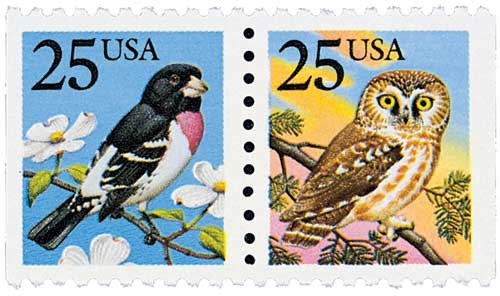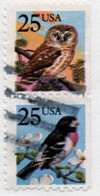
# 2284-85 - 1988 25c Owl and Grosbeak
U.S. #2284-85
1988 25¢ Owl and Grosbeak
- From booklet pane with unique checkerboard layout
- Originally intended to be one stamp design
Stamp Category: Definitive
Value: 25¢, first-class rate
First Day of Issue: May 28, 1988
First Day City: Arlington, Virginia
Quantity Issued: 1,706,910,000
Printed by: Bureau of Engraving and Printing
Printing Method: Photogravure
Format: Booklet panes of 10 in printing cylinders of 480
Perforations: 10 on 2 or 3 sides
Please note: Due to the layout of the pane, the se-tenant may or may not be provided in Scott Catalogue order.
Why the stamps were issued: This booklet, as with the Pheasant booklet issued a month earlier, was part of a USPS response to customer calls for more colorful and interesting booklet stamps. The USPS contacted go-to wildlife artist Chuck Ripper, asking him to suggest a bird that hadn’t been included in the 1982 State Birds and Flowers pane or the 1987 American Wildlife pane. As he often did, Ripper submitted two different designs and USPS was so pleased with both, they decided to include both in the booklet, instead of just one. (It turned out the saw-whet owl had been included in the 1978 American Owls issue, but the USPS was undeterred.) The booklet is arranged in a unique checkerboard pattern to accommodate both subjects.
About the stamp designs: Chuck Ripper created his artwork for these stamps based on his own photos and sketches of the birds. The grosbeak is pictured perched on a flowering dogwood against a blue sky, while the owl sits in an eastern hemlock with a multicolored background suggesting sunrise or sunset.
First Day City: The First Day ceremony for these stamps was held at the opening of the National Philatelic Exhibitions of Washington (NAPEX) show at the Sheraton National Hotel in Washington, DC. After the ceremony, a strip of stamps was cut, signifying the opening of the exhibition.
History the stamps represent: A member of the finch family, the rose-breasted grosbeak is found mainly in the Northeast. Like many of our other fine-feathered friends, the bright colors are restricted to the males.
Each spring, the rose-breasted grosbeak begins its migration from parts of Mexico, Central America, and South America. A long-distance traveler, this grosbeak journeys all the way to the young forests of the northeastern United States and Canada.
Upon arrival at the breeding territory, the male grosbeak, like many songbirds, serenades prospective mates and performs an elaborate courtship display. The pair then builds their nest together, taking turns incubating the eggs and feeding the hatchlings. Throughout the season, they will continuously sing to each other, even when sitting in the nest and during the nighttime hours.
While the male grosbeak is easily recognized for the bright-red chevron, or “V,” on his white breast during the spring and summer months, he and his female counterpart are best known for their remarkable songs.
The rose-breasted grosbeak whistles sweet songs lasting up to six seconds and consisting of multiple notes that rise and fall harmoniously. In the early 20th century, naturalists remarked that its song “has been compared with the finest efforts of the robin…and the scarlet tanager, but is far superior to either.” Some even say that the rose-breasted grosbeak sounds like an American robin that has had opera training.
Nearly the same size as the grosbeak, the saw-whet owl is one of the smallest birds of prey. His fine-tuned senses, such as binocular-like eyesight and his keen hearing, plus the fluffy plumage, which allows him to swoop down silently on his prey, make him a superb hunter. The saw-whet owl is only seven inches long and weighs less than four ounces. When it is threatened, it can lengthen its body so it looks like a tree branch.
U.S. #2284-85
1988 25¢ Owl and Grosbeak
- From booklet pane with unique checkerboard layout
- Originally intended to be one stamp design
Stamp Category: Definitive
Value: 25¢, first-class rate
First Day of Issue: May 28, 1988
First Day City: Arlington, Virginia
Quantity Issued: 1,706,910,000
Printed by: Bureau of Engraving and Printing
Printing Method: Photogravure
Format: Booklet panes of 10 in printing cylinders of 480
Perforations: 10 on 2 or 3 sides
Please note: Due to the layout of the pane, the se-tenant may or may not be provided in Scott Catalogue order.
Why the stamps were issued: This booklet, as with the Pheasant booklet issued a month earlier, was part of a USPS response to customer calls for more colorful and interesting booklet stamps. The USPS contacted go-to wildlife artist Chuck Ripper, asking him to suggest a bird that hadn’t been included in the 1982 State Birds and Flowers pane or the 1987 American Wildlife pane. As he often did, Ripper submitted two different designs and USPS was so pleased with both, they decided to include both in the booklet, instead of just one. (It turned out the saw-whet owl had been included in the 1978 American Owls issue, but the USPS was undeterred.) The booklet is arranged in a unique checkerboard pattern to accommodate both subjects.
About the stamp designs: Chuck Ripper created his artwork for these stamps based on his own photos and sketches of the birds. The grosbeak is pictured perched on a flowering dogwood against a blue sky, while the owl sits in an eastern hemlock with a multicolored background suggesting sunrise or sunset.
First Day City: The First Day ceremony for these stamps was held at the opening of the National Philatelic Exhibitions of Washington (NAPEX) show at the Sheraton National Hotel in Washington, DC. After the ceremony, a strip of stamps was cut, signifying the opening of the exhibition.
History the stamps represent: A member of the finch family, the rose-breasted grosbeak is found mainly in the Northeast. Like many of our other fine-feathered friends, the bright colors are restricted to the males.
Each spring, the rose-breasted grosbeak begins its migration from parts of Mexico, Central America, and South America. A long-distance traveler, this grosbeak journeys all the way to the young forests of the northeastern United States and Canada.
Upon arrival at the breeding territory, the male grosbeak, like many songbirds, serenades prospective mates and performs an elaborate courtship display. The pair then builds their nest together, taking turns incubating the eggs and feeding the hatchlings. Throughout the season, they will continuously sing to each other, even when sitting in the nest and during the nighttime hours.
While the male grosbeak is easily recognized for the bright-red chevron, or “V,” on his white breast during the spring and summer months, he and his female counterpart are best known for their remarkable songs.
The rose-breasted grosbeak whistles sweet songs lasting up to six seconds and consisting of multiple notes that rise and fall harmoniously. In the early 20th century, naturalists remarked that its song “has been compared with the finest efforts of the robin…and the scarlet tanager, but is far superior to either.” Some even say that the rose-breasted grosbeak sounds like an American robin that has had opera training.
Nearly the same size as the grosbeak, the saw-whet owl is one of the smallest birds of prey. His fine-tuned senses, such as binocular-like eyesight and his keen hearing, plus the fluffy plumage, which allows him to swoop down silently on his prey, make him a superb hunter. The saw-whet owl is only seven inches long and weighs less than four ounces. When it is threatened, it can lengthen its body so it looks like a tree branch.











